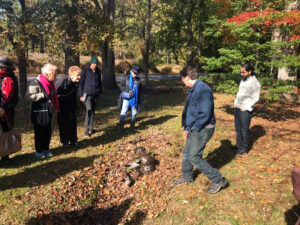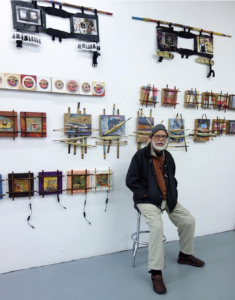Currently on view at Phillips@THEARC is What a Relief: small relief sculptures, organized with the Washington Sculptors Group (WSG). 2021-22 Sherman Fairchild Fellow Shiloah Coley speaks with board members of WSG and participating artist Alonzo Davis.

Members of Washington Sculptors Group view Adam Bradley’s Struggle at WSG’s show, ARTINA 2021: Balancing Acts, at the Sandy Spring Museum
Artists helping artists—that’s what the Washington Sculptors Group has been doing for nearly 40 years as one of the oldest and largest sculptor groups nationally. “And that’s how the group started,” said Joan Weber, advisory board liaison of WSG. “It had been a bunch of sculptors in their studios alone, lonely, and wanting to talk about materials.”
The Phillips Collections recently partnered with Washington Sculptors Group to present WHAT A RELIEF: small relief sculptures at Phillips@THEARC, juried by the Phillips’s Nehemiah Dixon III, Director of Community Engagement, and Vesela Sretenović, Cross-departmental Director of Contemporary Art Initiatives and Partnerships. This is the inaugural in-person exhibition held at Phillips@THEARC since the onset of the pandemic.
Works by 37 artists ranging in age from 15 to 81 were selected for the show. Alonzo Davis, member of WSG for nearly 15 years, had his piece Microclimate VI accepted into the show.

Alonzo Davis, Photo: Sheena Asun
Davis’s life and career spans across the US and internationally from Brazil to West Africa, but he’s called Maryland home for the past 20 years. When he first found a studio to rent in Baltimore in 2002 from fellow artist Ivy Parsons, she told him about WSG. New to the area, Davis decided to join. “I liked the opportunities they presented for artists, and a lot of the exhibits and dialogue,” Davis said. “It was a network.”
His story of being introduced to the group is not uncommon in WSG. Many more senior members heard about it via word of mouth from other artists back in the day. “And they got together, and the meetings were held in each person’s studio–that person was responsible for wine and cheese,” said Weber. “And then, they had their meeting, really a community-based, let’s get together event.”
As the organization updated and shifted into the early 2000s, some began to stumble upon the organization online. Steve Wanna, exhibition manager of WSG, came across the group just as he was beginning to dip back into visual art and sculpture. He describes himself as lurking on their online presence, but feeling intimidated to join what appeared to be a highly professional organization. He soon found out it was a grassroots collective of artists.
“It is a very robust organization that is entirely volunteer run, entirely member-driven,” shared Wanna. “We do a ton of work for what seems like an impossibly small budget, and somehow it works, and it works pretty spectacularly.”
The entire operation is run from the ground-up with not a single paid position. So when the pandemic hit in March of 2020, it’s no surprise that artists continued to help artists. “It’s like positive peer pressure in a way. We somehow ended up doing way more than we normally do during the pandemic, which I think is the case for a lot of people,” Wanna said.
As they moved virtual, they introduced Zoom happy hours in place of studio gatherings and webinars for professional development. Pre-pandemic, the organization provided three shows annually for their members to submit work to. In 2020 and 2021, that number increased to five. Weber said, “It’s like you’re not doing enough so you run double time.”

Installation image of What a Relief: small relief sculptures, featuring Jean Sausele-Knodt, Fragment Dance, Three (2021), and more. Photo credit: Ryan Maxwell
Meanwhile, they managed to decrease their costs during the pandemic. Outdoor venues helped cut costs by assisting with installations, and they spent less money to promote and advertise shows.
After moving virtual, membership increased from international artists and artists across the country, from Australia to California. Many artists found themselves alone and a bit lonely since the onset of the pandemic with less in-person studio visits on the schedule and timed-tickets limited to small groups for visiting exhibitions. Alonzo Davis still spends most of his time in his studio even as the world around him begins to open up. He’s seen the work from What a Relief online and shares, “It’s fascinating seeing how people come to the relief in so many different ways.”
